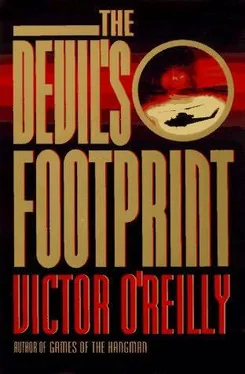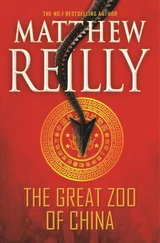Victor O'Reilly - The Devil's footprint
Здесь есть возможность читать онлайн «Victor O'Reilly - The Devil's footprint» весь текст электронной книги совершенно бесплатно (целиком полную версию без сокращений). В некоторых случаях можно слушать аудио, скачать через торрент в формате fb2 и присутствует краткое содержание. Жанр: Триллер, на английском языке. Описание произведения, (предисловие) а так же отзывы посетителей доступны на портале библиотеки ЛибКат.
- Название:The Devil's footprint
- Автор:
- Жанр:
- Год:неизвестен
- ISBN:нет данных
- Рейтинг книги:5 / 5. Голосов: 1
-
Избранное:Добавить в избранное
- Отзывы:
-
Ваша оценка:
- 100
- 1
- 2
- 3
- 4
- 5
The Devil's footprint: краткое содержание, описание и аннотация
Предлагаем к чтению аннотацию, описание, краткое содержание или предисловие (зависит от того, что написал сам автор книги «The Devil's footprint»). Если вы не нашли необходимую информацию о книге — напишите в комментариях, мы постараемся отыскать её.
The Devil's footprint — читать онлайн бесплатно полную книгу (весь текст) целиком
Ниже представлен текст книги, разбитый по страницам. Система сохранения места последней прочитанной страницы, позволяет с удобством читать онлайн бесплатно книгу «The Devil's footprint», без необходимости каждый раз заново искать на чём Вы остановились. Поставьте закладку, и сможете в любой момент перейти на страницу, на которой закончили чтение.
Интервал:
Закладка:
Fitzduane nodded. "It gets complicated when you are talking combined arms, because armor does not operate in a vacuum. Add helicopters into the equation and FAV's might not have done so well. Also, the Abrams tank and the Humvee programs were well advanced and big money was involved, and no one wanted to lose them. So, for all practical purposes, the FAV experiment was killed. I hear the marines bought a few, and the SEALs certainly took them on board with success, but major development, which was what the program needed, never happened. It should have, because FAV funding would have been chicken feed in comparison to most military programs, but it didn't. That's the trouble with inexpensive programs. There is not enough money in them."
Kilmara smiled. "Well, since we don't have any real budget by American standards, we picked up on the U.S. experience and some work in the U.K. and produced our own machine, but decided to try a slightly different direction. Both the Chenowth and the Saker are wheeled vehicles, excellent for some terrains but no good in marshy ground or snow.
"But we don't have the money to have different vehicles for different conditions, so we decided to go for an unarmored high-speed tracked machine that could do most of what the Chenowth and Saker could do but could operate worldwide. Sand, mud, rocky shale, snow, ice, marshy ground – the Guntrack can go just about anywhere. The intention is to equip it with enough firepower to knock out a tank and handle any immediate aerial threat, and it is the weapons aspect that we are still working on. Want to see it, Don?"
Shanley was not used to generals being this informal. He was a courteous man by nature and had found that around the U.S. Army, a crisp "Sir" did not go amiss. "Yes, sir!" he said.
Kilmara looked at him. "We're an informal culture these days in Ireland," he said. "First names are normal. I'm Shane. He's Hugo, and he-" he indicated Maury – "I think he is mellowing."
"Maury," said Maury. He was looking downright agreeable.
Fitzduane slipped in the video.
The group turned toward the screen.
The terrain was rocky undulating ground covered with outcrops of heather and patches of rough grass. In the background there was a line of hills under a lowering sky that was a surreal mix of menacing clouds and shafts of light.
It was a bleak but dramatic landscape that encompassed an extraordinary variation of shape and line and shade and color. It was stunningly beautiful, and Shanley suddenly realized that this was not just some foreign land.
This was where his roots lay. This had once been home.
A dark shape appeared in the distance. It was hard to make out the details. The silhouette was low and indistinct. The vehicle approached following a zigzag course and across land that would have been impassable in a wheeled vehicle. The sound track suggested it made surprisingly little noise.
The vehicle came closer and drove parallel past the camera so it could be seen in profile. As it did so, it could be seen that although the tracks were riding over rocks and a generally uneven surface, the upper portion of the vehicle was virtually stable.
The driver locked one track and the Guntrack did a 360-degree turn on its own axis and then came to a complete halt.
It was like nothing either Don or Maury had ever seen. It was a small, low black box on tracks with a wedge-shaped front and what looked like folded-up forklift prongs on the rear. A driver and a gunner equipped with twin 5.56mm Minimi machine guns sat in the front.
The vehicle was steered by left-hand drive. To the right of the front gunner, a Stinger antiaircraft missile was clipped into position. Behind the two front seats was a gunner with an M19 belt-fed 40mm grenade launcher mounted on buffered soft mount attached to a turret ring. As they watched, the rear gunner's station rose on a hydraulic mount to give him a wider field of fire. The entire station then rotated 360 degrees. It then retracted and a slim mast mounting a miniature FLIR monitor rose up and panned in a circle.
"The Guntrack," said Fitzduane, "is the vehicle that the Irish Rangers are beginning to use for special operations. It is not armored in the traditional sense, but it is made from a special plastic that will withstand small-arms fire, and the tracks are a Kevlar and artificial rubber blend. Hell of a good power-to-weight ratio. Accelerates like a rocket and does up to eighty-five miles an hour with a full payload. The weapons fitted can, of course, be varied, but fully equipped with something like you see, it should cost no more than five percent of a tank. As to maintenance, if I can exaggerate just a little to make a point, it can be maintained by the three-man crew with their Swiss Army knives."
The video continued for another fifteen minutes as the camera focused in close-up on individual aspects. Everything from fuel consumption to changing an engine was covered. In fact, it was the attention to detail that was most impressive and ingenious.
The fuel tank, for instance, was of a honeycomb design that could be penetrated by an incendiary round without igniting. The forks at the back could be lowered to pick up a standard NATO pallet holding up to a ton. Guntracks could be linked so that if the engine on one went, the second could pull the first under power.
Shanley and Maury watched with fascination. The sheer logic of the thinking was impressive. The Guntrack had been designed by people who knew the reality of combat.
Maury could still see a problem. "Artillery will make mincemeat of you," he said. "Potentially, there is a terrifying amount of unfriendly metal on today's battlefield, and much of it will cut right through your plastic box."
"The Guntrack is not the ultimate weapon," said Fitzduane. "It is no more than one more useful tool. It is designed for a shoot-and-scoot approach to survival. It is primarily a better way, we think, to get around when you are on the ground on some special operations missions. The underlying idea is not to be detected at all, but if you are detected, to have enough firepower to make the enemy back off while you hightail it out of the area. It beats the hell out of dying."
Shanley had been thinking it through. "How do you use Guntrack tactically?" he said.
"We've found that the minimum practical deployment is two vehicles," said Fitzduane. "Then fire and movement. One covers the other like a fighter pilot and his wingman."
Kilmara turned to face Shanley and Maury. "Well, gentlemen," he said. "Now you know what we are working on. The next question is what you can suggest. Any ideas?"
"More than a few," said Shanley. His mind was racing. What he had seen, if properly developed, was not just interesting. It was tactically significant.
"This idea of a small, inexpensive fast attack vehicle taking on tanks reminds me of something that happened in Africa. The Libyans tried to grab their neighbor to the south and assembled an invading army of hundreds of tanks. They were beaten by Chadians driving only Toyota pickup trucks equipped with Milan missiles. The pickups maneuvered faster than the Russian tanks could move their turrets. Also, they were so small they were hard to hit."
Kilmara, who had been in Chad advising the Chadians at the time, did not say anything but looked at Shanley with renewed respect. This was a man who did his homework.
"You should look at Dilger's Baby," said Maury cryptically.
Fitzduane and Kilmara looked at each other blankly.
"How does a baby fit into all this, Maury?" said Kilmara carefully. Maybe Maury had finally flipped.
Maury beamed. "You'll see," he said.
When the meeting broke up, Fitzduane checked the switchboard to see if Kathleen had checked in. If she went on an expedition, she normally called during the day to say roughly when she would be back.
Читать дальшеИнтервал:
Закладка:
Похожие книги на «The Devil's footprint»
Представляем Вашему вниманию похожие книги на «The Devil's footprint» списком для выбора. Мы отобрали схожую по названию и смыслу литературу в надежде предоставить читателям больше вариантов отыскать новые, интересные, ещё непрочитанные произведения.
Обсуждение, отзывы о книге «The Devil's footprint» и просто собственные мнения читателей. Оставьте ваши комментарии, напишите, что Вы думаете о произведении, его смысле или главных героях. Укажите что конкретно понравилось, а что нет, и почему Вы так считаете.












